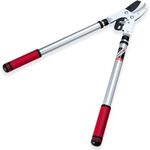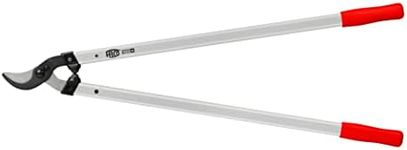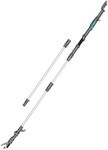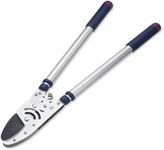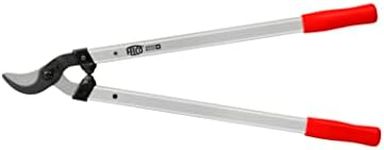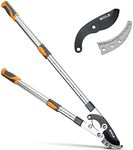Buying Guide for the Best Garden Loppers
Choosing the right garden loppers can make your gardening tasks much easier and more efficient. Garden loppers are essential tools for cutting through thick branches and stems, and selecting the right one involves considering several key specifications. Understanding these specs will help you find the best fit for your gardening needs.Blade TypeThe blade type is crucial because it determines how cleanly and efficiently you can cut through branches. There are two main types: bypass and anvil. Bypass loppers have two blades that slide past each other, similar to scissors, and are ideal for cutting live branches as they make clean cuts that promote healthy growth. Anvil loppers have a single straight blade that cuts against a flat surface, making them better suited for cutting dead or dry branches. Choose bypass loppers for live plants and anvil loppers for dead wood.
Blade MaterialBlade material affects the durability and sharpness of the loppers. Common materials include stainless steel, carbon steel, and titanium-coated steel. Stainless steel blades are resistant to rust and easy to maintain, making them a good all-around choice. Carbon steel blades are very sharp and durable but require more maintenance to prevent rust. Titanium-coated blades offer extra durability and rust resistance. If you want low maintenance, go for stainless steel; if you need extra sharpness and durability, carbon steel or titanium-coated blades are better.
Cutting CapacityCutting capacity refers to the maximum diameter of branches that the loppers can cut. This is important because it determines the size of branches you can handle. Cutting capacities typically range from 1 inch to 2 inches. If you have a garden with thicker branches, opt for loppers with a higher cutting capacity. For smaller, more delicate plants, a lower cutting capacity will suffice.
Handle LengthHandle length affects both the leverage you have and the reach of the loppers. Longer handles provide more leverage, making it easier to cut through thicker branches, and they also allow you to reach higher branches without a ladder. However, they can be heavier and harder to maneuver. Shorter handles are lighter and easier to control but offer less leverage and reach. Choose longer handles for heavy-duty tasks and shorter handles for precision and ease of use.
WeightThe weight of the loppers can impact how comfortable they are to use, especially for extended periods. Heavier loppers may provide more cutting power but can be tiring to use. Lighter loppers are easier to handle and less fatiguing but may not be as powerful. Consider your physical strength and the duration of your gardening tasks when choosing the weight. If you need to work for long periods or have limited strength, opt for lighter loppers.
Ergonomic FeaturesErgonomic features, such as cushioned grips and adjustable handles, can significantly enhance comfort and reduce strain during use. These features are important for preventing hand fatigue and ensuring a secure grip. Look for loppers with ergonomic designs if you plan to use them frequently or for extended periods. This will make your gardening experience more enjoyable and less physically taxing.
